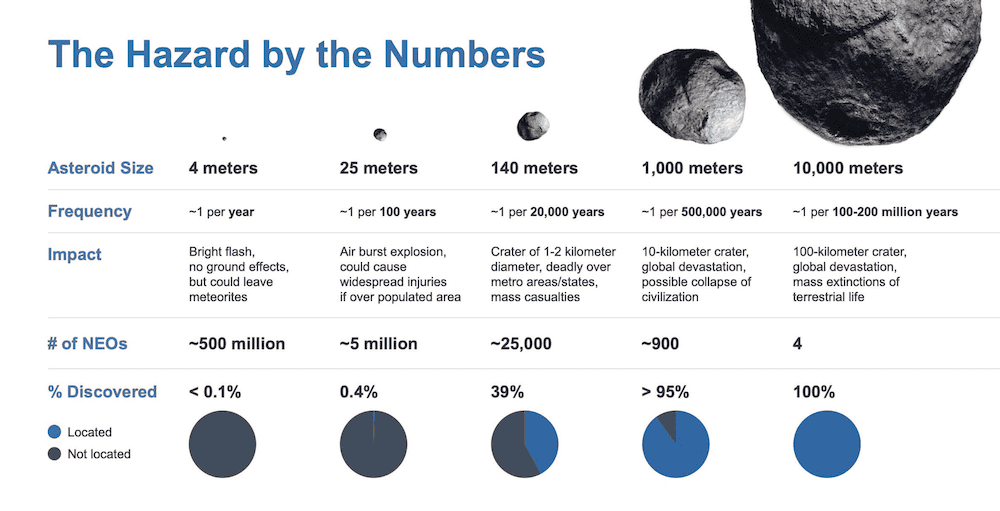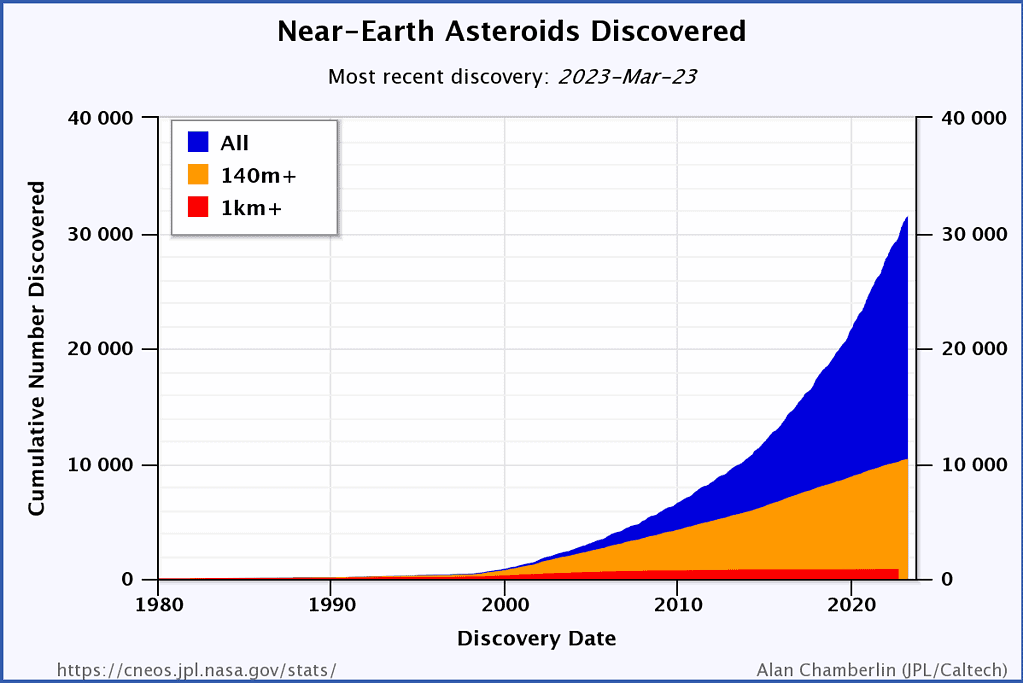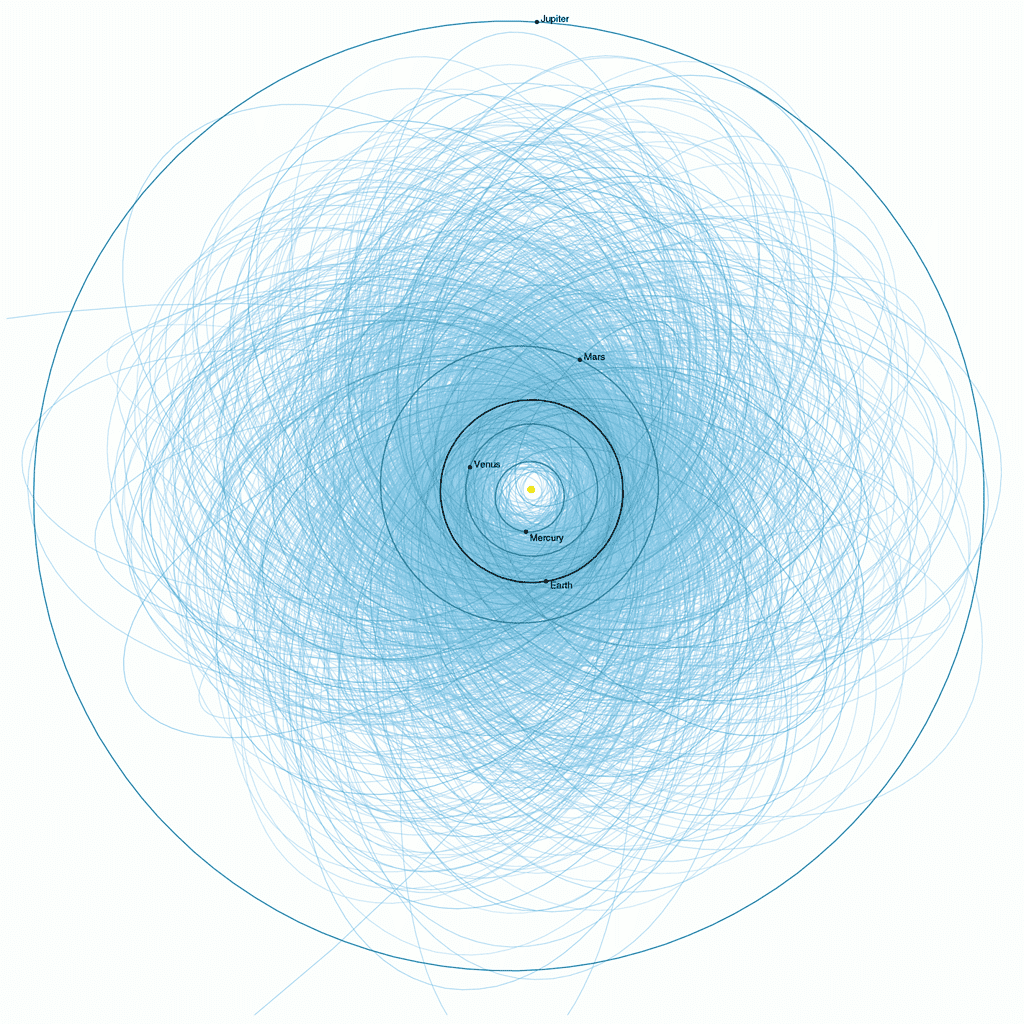Asteroids are fascinating and frightening. Sure, on the one hand, they’re rocks hurling through space on their own, and possibly seeded water and even life on Earth and other planets — and that’s cool — but on the other hand, they can smash into our planet and cause a lot of damage.
Dinosaurs were famously wiped out by an asteroid impact and while not as famous, several other asteroids also made a big impact on our planet — quite literally. So it’s understandable that we have so many movies about asteroids about to hit Earth (even though they usually get the science very wrong). It’s also understandable that people get spooked by asteroids, especially as there seems to be a new report on asteroids every week.
You’ve probably seen them: they use weird comparisons for sizes (“giraffe-sized,” anyone?) and they either overstate the risk or don’t explain it at all. Asteroids can indeed be dangerous, but this risk is probably smaller than you think. Let’s dig in deeper.

Big asteroids, small asteroids
So far, astronomers have found hundreds of thousands of asteroids in our solar system — and every year, they’re finding thousands more. Some are only a couple of meters across. Others are worthy of being called ‘dwarf planets,’ like Ceres, which measures 933 km in diameter. Most of these are nowhere near Earth and are not of any concern. But smaller asteroids are much more common.
To completely wipe out life on Earth (or almost completely), an asteroid would have to be around 100 km across (60 miles). But those aren’t the ones you should be worried about.
When it comes to asteroids that are 10 km (6 miles) across or more, there are very few of those in the near-Earth orbit. This is the type of asteroid that wiped out the dinosaurs and would quite likely wipe us out too. At the very least, it would cause widespread extinction and devastation across the globe. But there are only 4 of them in our vicinity, and researchers are pretty confident we’re not going to encounter one that’s dangerous to Earth.
But when it comes to asteroids that are between 1 and 10 km across, that’s when it gets trickier.
Planet killers and city killers

These asteroids are the so-called planet killers, and this is where concerns should start. There are far more of them, to begin with: astronomers have discovered 900 near-Earth objects (or NEOs) in this size range. Researchers believe we’ve discovered the vast majority of them — but not all.
It’s estimated that 95% of asteroids greater than 1 km have been discovered. That sounds reassuring until you realize that means that 5% haven’t been discovered. Researchers are constantly looking for more, but we don’t yet have a complete list.
If such an asteroid hit Earth, it could be a “planet killer.” It’s not that it’s powerful enough to destroy us directly, but it would probably cause enough damage to trigger a collapse of civilization and fuel a chain reaction of extinctions. The impact would be so great that it would create a crater that’s several kilometers across. It’s estimated that such an asteroid hits Earth once every 500,000 years. The periodicity is not fixed, it’s more like an approximation.
City killers (asteroids ranging from 140 meters to 1,000 meters) are even trickier. These are the asteroids that could wipe out metropolitan areas or even a small country. We’ve probably discovered only around half of these, and while new powerful observatories will contribute to this figure, there’s still a lot we don’t know yet.
There are probably around 25,000 NEOs in this size range and they hit the Earth much more frequently — once every 20,000 years or so.
When it comes to even smaller asteroids, the ones that are just a few meters across, we only know a small fraction. Yet these “giraffe-sized” NEOs could still cause a lot of damage, so it’s understandable that they still receive a lot of attention. But how often do they pass by?
How close do asteroids pass us?
For an asteroid or a comet to be classed as a NEO, it has to be at a distance of 1.3 AU. The AU, or astronomical unit, is defined as the distance between the Earth and the Sun. So asteroids could be farther away from the Earth than the Earth is from the Sun and they’d still be an NEO.
To be classed as ‘potentially hazardous,’ an asteroid has to have a Minimum Orbit Intersection Distance (MOID) with the Earth of 0.05 AU. That seems pretty close, but here’s some reference: the average distance from the Earth to the Moon is 0.0026 AU (or 384,400 km). So in other words, an object can pass the Earth 20 times farther away than the Moon and it’s classified as ‘ potentially hazardous’. There’s another requirement: the object has to be larger than 140 m; it has to be a city killer.
There are around 2,300 potentially hazardous objects known. Researchers estimate that we’ve probably discovered around 99% of them. That sounds pretty concerning, but again, they’re not that close. Orbit calculations aren’t perfect — but again, most asteroids pass way farther away than the Moon is.

Astronomers consider anything passing closer than the moon to be a “close approach.” Yes, “close” means something different for astronomers. In 2022 there were 126 close approaches, and that’s probably an average number. In 2023 we’ve had 50 so far.
We can also calculate how many close approaches are for different types of asteroids. Here’s how a rough calculation would work:
- let’s take a ‘city killer’ asteroid that would hit Earth once every 20,000 years;
- if the Earth’s surface were two times bigger, you’d be twice as likely to get hit by an asteroid. So the frequency of impact would also be doubled — so once every 10,000 years;
- the Earth’s radius is 6,400 km. To get to a sphere with twice that surface, you’d need a volume of 9,000 km (because the radius increases with the square root of surface area);
- so this fictional sphere was hit by a city killer 10,000 years ago, and this fictional sphere extends 2,600 km of Earth (9,000 minus 6,400). In other words, every 10,000 years, one city killer comes within 2,600 km of Earth.
Repeat the same calculation for different values and you can assess how likely different asteroids are to pass at different distances from Earth.
- if you increase the surface area by a factor of 100, the frequency also decreases by a factor of 100 (so once every 200 years);
- in this case, the radius increases by 10 times (because the square root of 100 is 10);
- this would translate to a radius of 57,000 km (64,000 minus 6,400);
- this means that our city killer asteroids pass within 57,000 km every 200 years.
This is a very rough estimate, but it fits with current observations.
But as you can see, it gets pretty complex to gauge just how dangerous an asteroid is and how significant its passing is. So researchers designed a better, simpler way.
A better way to class asteroids
The Torino Scale is a method for categorizing the impact hazard associated with near-Earth objects. It is intended to convey the seriousness of collision risks from NEOs to both the public and the scientific community. Named after the city of Turin (Torino in Italian) where it was first proposed in 1999, the scale has since been adopted by various astronomical organizations.
The scale is divided into 10 categories, numbered from 0 to 9. It takes into consideration several factors, including the size of the object, its velocity, trajectory, and the probability of impact. Essentially, the scale includes how likely the asteroid is to hit our planet and how much damage it would do.

Here’s a summary of the scale:
| Rating | Description |
|---|---|
| 0 | No hazard. The likelihood of a collision with Earth is zero or well below the chance that a random object of the same size will impact Earth within the next few decades. |
| 1 | Normal. A routine discovery in which a pass near the Earth is predicted that poses no unusual level of danger. |
| 2 | Meriting attention by astronomers. The chance of collision is extremely unlikely but of greater probability than for Level 1. |
| 3 | A close encounter, meriting attention by astronomers, with a 1% or greater chance of collision capable of localized destruction. |
| 4 | A close encounter, meriting attention by astronomers, with a 1% or greater chance of collision capable of regional devastation. |
| 5 | A close encounter posing a serious, but still uncertain threat of regional devastation. |
| 6 | A close encounter by a large object posing a serious but still uncertain threat of a global catastrophe. |
| 7 | A close encounter by a large object posing a serious but still uncertain threat of a global catastrophe. Potential for a global climatic catastrophe. |
| 8 | A collision capable of causing localized or regional devastation. Certain (≥99%) collision, capable of causing a global climatic catastrophe. |
| 9 | A collision capable of causing a global climatic catastrophe. Certain (≥99%) collision, resulting in global devastation. |
The highest rating on the Torino scale we’ve had was Apophis. This near-Earth asteroid is 370 meters in diameter and in 2004, it was rated level 2. Its rating was subsequently upgraded to level 4 — this is still, to this day, the current record. Apophis is set to pass by Earth in 2029, and there were some uncertainties about its orbit. Current models say it will pass some 38,000 km from Earth and its level was downgraded to 0.
No other incoming object has been graded a level 4 or higher. In fact, no object currently has a non-zero designation. Several asteroids were downgraded to 0 in 2023, including one asteroid called 2023 JE5, which has a diameter of around 34 meters. Researchers initially calculated a 1 in 480 chance of impact on 4 October 2017. However, more refined calculations showed that the chance is rather 1 in 3,000.
If you’re concerned about an asteroid, check the Torino scale
So there you have it — instead of talking about Manhattan-sized or giraffe-sized asteroids that pass “close” to Earth, let’s take about the Torino scale. Is it a zero? Then yeah, no reason for concern.
This doesn’t mean there’s nothing to worry about in general. We don’t know all the asteroids yet, and sometimes, there are uncertainties about orbit calculations. We absolutely should continue supporting the discovery and study of asteroids — especially as recent satellite constellations can be quite obtrusive.
We’re not helpless. As the DART missions showed, we have a good shot to deflect a dangerous asteroid. In order to have any chance of that working, we need to detect this potential asteroid as early as possible.
But all this talk of “bus-sized” asteroids passing “close” doesn’t really mean much. When you read an article like this, check if it mentions the Torino scale or any specifics on how likely it is to actually impact the Earth in a meaningful way. If it doesn’t do any of that, just ignore it.




